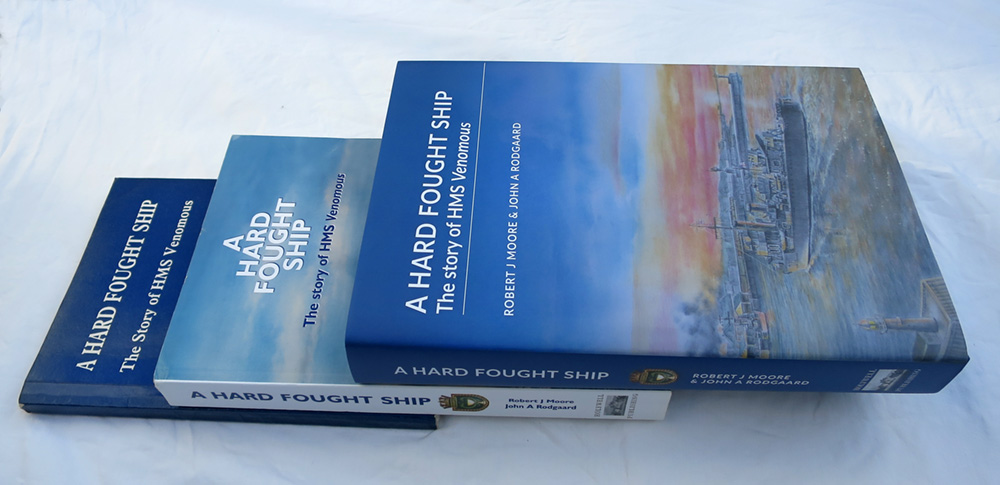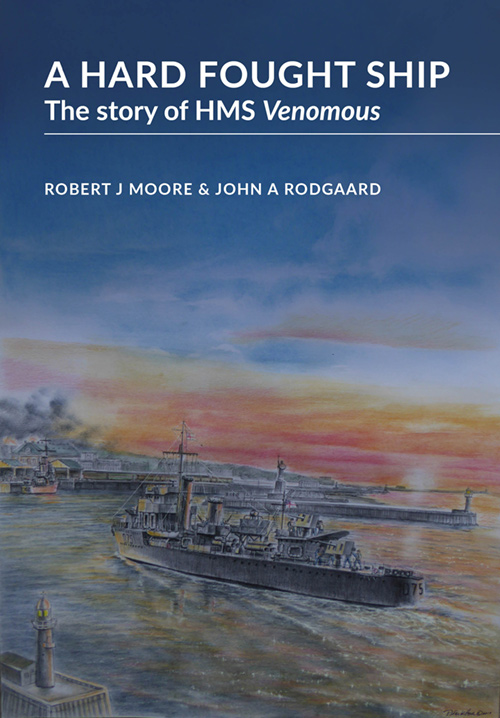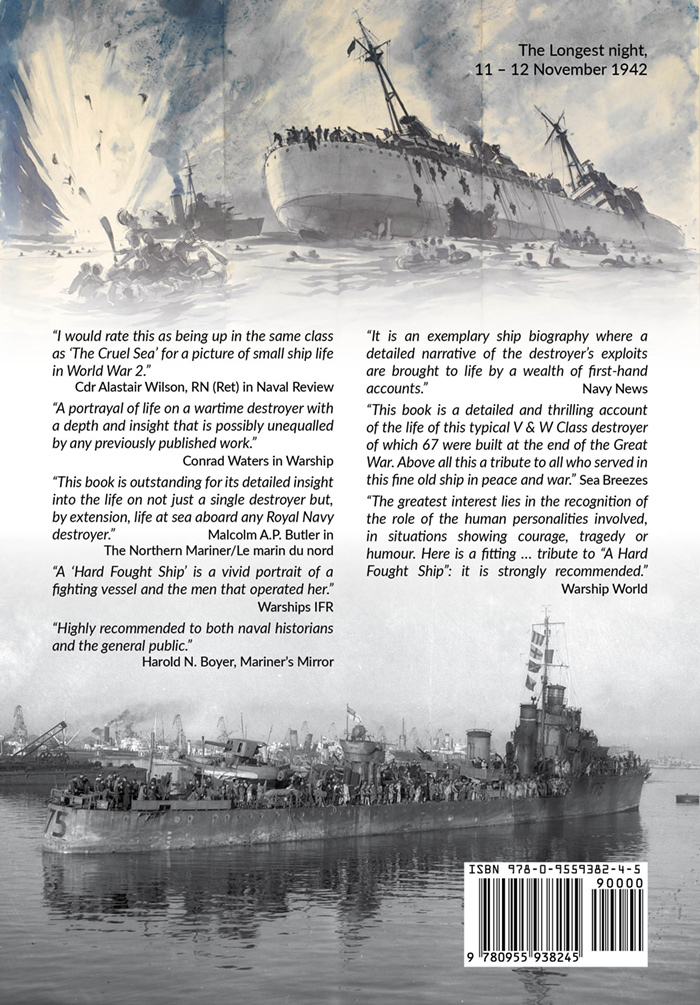A HARD FOUGHT SHIP
The
story of HMS Venomous
by R.J. Moore and J.A. Rodgaard
Holywell House Publishing, 9 May 2017
244x170 mm with 480 pp, 256 photographs and 12 maps and plans
ISBN 978-0-9559382-4-5; hardback, £35 (including post & packaging in UK)
Out of print - e-book edition out in Spring 2023
The hardback edition is linked to the Internet by the notes at the end of each chapter
From a 140 page paperback with 18 illustrations to a 480 page hardback with 256 illustrations in 2017
with list of "Illustrations" followed by the "Notes" at the end of chapters with live links
"The notes at the end of
chapters include links to PDFs of the original Reports of Proceedings, interviews, video clips, music and web pages
Click on the chapter heading to
see the list of illustrations followed by the endnotes with live links."
Bill Forster, Holywell House Publishing
Take a peep inside at some typical pages
"The book does indeed look superb, the first thing I notice is that all
the photographs look so much more clear and light-filled,
and the print
and paper quality crisper and clearer as well"
Michel Sangster, son of Lt Tony Sangster RN, HMS Venomous (1942-3)
Foreword
Rear Admiral John Kingwell RN
Foreword to the first edition
Admiral Sir Frank R. Twiss KCB DSC RN
Introduction by the authors
Capt John Rodgaard USN (Ret)
Robert J Moore
A word from the publisher
William A. Forster
Acknowledgements
Chapter One:
PEDIGREE, 1893 - 1919
Describes how the invention of the torpedo led to the Torpedo Boat and the
development of the Torpedo Boat Destroyer (TBD) to protect the capital
ships of the world’s navies from this formidable new weapon. Rodgaard
compares the evolution of the TBD and the MTBD by the great powers and
compares the V & W Class of destroyers with the destroyers of the
US Navy, the French Navy, the Italian and the Imperial Japanese Navy.
Chapter Two:
WAR IN THE BALTIC AND TROUBLE AT HOME, 1919-23
HMS Venomous was built at John Brown's shipyard on the Clyde and at the start of her first Commission on the 17 June 1919 steamed south to take part in the Fleet
Review at Southend to celebrate the end of the Great War and was then sent to Scapa Flow
to help salvage the scuttled German High Sea Fleet. During her first
Commission Venomous helped the Baltic States defend themselves against
Russian Bolshevik forces and a renegade German general and quelled
social unrest in Britain and political unrest in Ireland.
Chapter Three:
THE MEDITERRANEAN YEARS, 1923-9
The chapter describes the changing role of the destroyer after the Great War and the cuts imposed by the “Geddes
Axe” and international agreements which limit the size of of the world's navies. Despite this the 1920s are “the
heydays of the V & W boats”. The peacetime routine of the Navy was built around Spring
and Autumn cruises, regattas and exercises to keep both ships and men
in constant readiness. Extracts from the diary of an anonymous stoker
and the journal of a young sub lieutenant on Venomous paint a contrasting picture of life for ratings on the lower deck and officers on the
quarterdeck of Venomous in the Mediterranean years.
Chapter Four:
OFF TO WAR, 26 SEPTEMBER 1938 – 2 MAY 1940
HMS Venomous was laid up at Chatham and Rosyth from 1929 but brought
back to operational condition in September 1938 when the Reserve Fleet
was mobilised during the Munich crisis. After the declaration of war on
the 3 September 1939 Venomous and her sister ships escorted the
requisitioned ferries taking the troops of the BEF to France. In
January 1940 Lt Cdr John McBeath succeeded Lt Cdr Donald McLean RN as
CO. A collision with a tug in Portsmouth harbour on 5 March led to her
spending two months under repair in the dockyard and missing the
Norwegian campaign.
Chapter Five:
CALAIS AND BOULOGNE, 2 - 26 MAY 1940
The German blitzkrieg of the Low Countries and France began on the 10
May bringing an end to the phoney war. Venomous
took part in operations off the Dutch coast, rescuing Jewish men an
women escaping from the Netherlands on a Dutch lifeboat and a joint
naval and trerritorial army demolition team from Ijmuiden. On the 21
May she evacuated the British community from Calais and the following
day she and her sister V & Ws took the Welsh and Irish Guards to
defend Boulogne only to evacuate them the next day while being dive
bombed by Stuka and under fire from German tanks in the harbour.
Chapter Six:
DUNKIRK, 27 MAY – 4 JUNE 1940
The
evacuation of the troops from Dunkirk began on the 27 May while HMS
Venomous was under repair in her home port of Devonport, Plymouth.
This chapter sets the five trips
made by Venomous to the beaches east of Dunkirk and the East Mole at
the entrance to Dunkirk harbour in the context of plans drawn up by Vice-Admiral Betram Home
Ramsay RN at Dover (VAD) for the evacuation of the BEF and includes the role of
Capt William Tennant RN, the SNO at Dunkirk, and the role of the
naval beach parties and that of Rear-Admiral Wake-Walker RN (Rear
Admiral Dover) directing the evacuation from his flagships offshore.
Chapter Seven:
HOLD THE NARROW SEA, June – September 1940
While HMS Venomous
was under repair at her home port of Devonport a 3-inch HA, dual
purpose (DP) gun replaced her second set of torpedo
tubes giving her some protection against aircraft. Venomous joined the 18th Destroyer Flotilla and was posted to Nore Command at Harwich on the 20 June. The Flotilla went on regular night patrols
to guard against an attempted invasion and assisted east coast convoys between Rosyth and Southend on
Sea within the Nore Command area, the
main threat being surprise attacks by fast German e-boats, bombing and mines - dropped by Heinkel He 115 seaplanes. Venomous took part in Operation Lucid, a plan to destroy the invasion barges being assembled in the Channel ports with "fireships" or, as Churchill put it, to "singe Mr Hitler's moustache" just as Drake had "singed the King of Spain's beard" in 1588.
Chapter Eight
MINED! November 1940 – February 1941
Venomous left Harwich for Greenock on 31 October to escort the aircraft carrier HMS Argus from the Clyde to Gib on the first leg of a mission to reinforce the air defence of Malta. The Med was an Axis lake and after Venomous left HMS Furious she continued under escort to Takoradi on the Gold Coast where her planes took off on the long flight across Africa to Egypt. Venomous
was transferred to Western Appproaches Command and joined the First
Escort Group at Londonderry led by Cdr "Jack" Broome RN in HMS Keppel.
On Christmas Eve John McBeath was succeeded as CO by Cdr H. Pitcairn
Henderson RN and on 30 December enroute to Liverpool she detonated a
mine near the mouth of the Mersey and was towed into Cammell Laird's
shipyard at Birkenhead where she remained under repair for two months
during which the Type 286 RDF (Radar) was installed.
Chapter Nine:
ATLANTIC ESCORT, February – November 1941
Venomous
rejoined the First Escort Group at Londonderry and escorted Atlantic
convoys to the Mid Ocean Meeting Point (MOMP), handed over the convoys
to Canadian escorts and dashed into Havelfjord, Iceland, to refuel. The
problems faced in keeping the slow moving merchant ships in orderly
columns, the loss of ships to U-Boats, the rescue of survivors and the
problem of meeting up with the incoming eastbound convoys are described.
On 2 July Cdr Henderson was replaced as CO by Cdr Hugh Falcon-Steward
RN and a week later Venomous broke down with condensor trouble south of Iceland and had to be towed into Havelfjord by HMS Sabre for repair alongside the destroyer depot ship, HMS Hecla. On 11 November 1941 in poor visibility Venomous collided with the escort leader HMS Keppel
and had to be towed to Loch Ewe for emergency repairs before continuing
under tow to the Clyde. Falcon-Steward was criticised by the Board of
Enquiry for his failure to use his Type 286 RDF.
Chapter Ten:
REFIT AND RECOMMISSIONING, December 1941 – April 1942
Repairs were completed by 29
December but the Admiralty decided Venomous would receive a major refit and she was
in dockyard hands at Troon for four months. Her officers were given
new apointments and her ship's company returned to barracks leaving
only a care and maintenance party aboard. During the refit
Falcon-Steward joined the Western Approaches Tactical Unit conducting
courses for escort commanders and his place as CO was filled by Lord
Teynham, Cdr Christopher J.H. Roper-Curzon RN. It
was thought that Venomous was converted to a Long Range Escort (LRE)
able to complete an Atlantic crossing without refueling but we now know
she remained a Short Range Escort (SRE) but was given the armament of
an LRE including the replacement of A-Gun by the Hedgehog
Anti-submarine mortar and the fitting of a one ton depth charge known
as "the Brute" in one of her torpedo tubes. She was also given the
improved Type 271 RDF in addition to her Type 286 RDF.
Chapter Eleven
ARCTIC CONVOY TO RUSSIA, April – May 1942
Her refit completed HMS Venomous
returned to Londonderry in April as Leader of the 21st Special Escort
Group with Cdr Hugh Falcon-Steward RN as Group commander and was
ordered to Seidisfjord on the east coast of Iceland to escort Arctic
Convoy PQ.15 to Murmansk. The escorts for this large Arctic convoy of
45 merchant ships included the CAM Ship Empire Morn and the "flak ship" HMS Ulster Queen (with Cdr Donal Scott McGrath as CO) but they could not prevent the
sinking of three ships by German He 111 torpedo bombers of the 26th
Bomber Wing at Banak near North Cape on 2 May. Includes aerial
photographs taken from one of the German aircraft and the stories of survivors of the SS Cape Corso which sank withing minutes.
After 16 long dreary days at the Russian naval base of Polyarny on the Kola inlet Venomous escorted return convoy QP.12 and saw the rocket boosted launch of Flying Officer John Kenadal's Hurricat from HMS Empire Morn, his successful attack on a German aircraft and his death when he parachuted out too late after his plane nose dived into the sea. Venomous
returned to Derry on 3 June and three weeks later PQ.17 headed north and
most of the merchant ships were lost when the escorts were "ordered to scatter".
Chapter Twelve
SAVING MALTA: OPERATION PEDESTAL, June – November 1942
Venomous spent the next month struggling to keep up with the Cunard liner Queen Elizabeth and the Lanstephen Castle
carrying troops from North America and after a further spell in
dockyard hands on the Clyde to repair leaking boiler tubes was prepared
for Operation Pedestal.
Venomous was part of the escort for the elderly aircraft carrier HMS Furious carrying Spitfires to reinforce the defence of Malta, Operation Bellows. As Furious flew off her planes south east of Majorca U-73 fired four torpedoes at HMS Eagle and the huge aircraft carrier with 1,160 men aboard sunk in about six minutes. With 537 survivors aboard Venomous and Wolverine escorted Furious back to Gibraltar. Wolverine rammed and sunk the Italian submarine Cobalto enroute. The convoy battled its way through to Malta and Venomous escorted Furious towards Malta to fly off more Spitfires, Operation Baritone.
Within two weeks of returning to Londonderry Venomous
was ordered to Havelfjord to escort Arctic Convoy PQ.18, the first
Arctic convoy since the disaster of PQ.17 when most of the merchant
ships were lost, but was forced to return to Havelfjord by engine
trouble. Venomous headed south to Gib with Convoy KX.4A, part of Operation Torch, the invasion of Morocco and the Vichy controlled colonies in North Africa.
Chapter Thirteen
THE LONGEST NIGHT, 11 – 12 November 1942
After two days in Gibraltar Venomous and HMS Marne were ordered to rendezvous with Convoy CF.7 west of the Canary Islands and escort the destroyer depot ships, HMS Hecla and HMS Vindictive to Gibraltar. Capt Hubert G.D. Acland in Vindictive
was the senior officer. The recent discovery of the reports of the COs
of all four ships make it possible for the first time to apportion blame
for the disaster which followed. Falcon-Steward
pursued an RDF bearing and Asdic contact of a stalking U-Boat leaving
the starboard side of the convoy unprotected. Werner Henke in U-515
evaded Venomous and took advantage of the gap in the screen to launch a successful attack on Hecla despite being sighted by an alert Gunnery Officer on the bridge of Vindictive, dismissed by Acland as being Venomous. The situation became more desperate when Marne was hit in the stern
and Falcon-Steward had to
reconcile the conflicting priorities of fighting the U-boat with saving
the survivors struggling in the water. The first hand accounts of
survivors, the photographs taken by Cyril Hely and Leslie Eaton and the
dramatic paintings of the South African war artist Herbert McWilliams make this one of the most exciting chapters in the book. Venomous reached Casablanca with 500 survivors crowding her deck and her tanks empty of fuel.
Chapter Fourteen
MEDITERRANEAN ESCORT, November 1942 – October 1943
Cdr
Hugh Falcon-Steward was succeeded by Cdr Maitland-Makgill-Crichton, a
charismatic multi-lingual officer loved by the men who was soon
succeeded by Lt Henry D. Durell, a modest unassuming officer popular in
the Wardroom. In May 1943 the Axis forces in north Africa
surrendered and Venomous
escorted KMS.14X, the first through convoy from Gib to Alex. A case of
cannibalism on a German lifesaving raft and their entry to
the recently liberated blockaded port of Tripoli in Italian colony of
Libya made
a deep impression on the ships company. They enjoyed cold beers and
bought souvenirs in Alex before escorting the second wave of troops
to the landings in Sicily, Operation Husky. Venomous was bombed after the troops landed at Syracuse and many of the gliders carrying parachutists to attack
the aifield at Catania north of Augusta were shot down by the merchant
ships when they overflew the convoy. Plagued by continuing engine problems Venomous was ordered home and arrived at Falmouth in October.
Chapter Fifteen
ON OTHER DUTIES ASSIGNED, November 1943 – May 1945
The ships
Company returned to barracks at Devonport and
Venomous was left in the docks of Silley Cox & Partners at
Falmouth with a small "care and maintenance party" aboard. Venomous was to be converted into
an Air Target Ship for Barracuda torpedo bombers (TBR) based at Douglas
in the Isle of Man but priority was given to preparing for the landings
on the Normandy beaches and she was on a mud berth for several months. She was still in the front line
as Falmouth was subjected to heavy bombing in the run up to D Day. It
was not until August that Venomous
left Falmouth at the start of her new Commission with a new CO, Lt Cdr
Derek Law RNVR and a new Wardroom and ship's company. This chapter
describing her humble new role is illustrated with striking new
photographs of the ship and the Baraccuda aircraft. In December Venomous
was transferred to Rosyth on the FIrth of Forth as a target ship for
TBR based at Crail and in January was nearly lost with the entire
ship's company when her anchor failed to hold on a lee shore in a
hurricane but was saved by the alertness of a young Midshipman and the
skill of her CO. Derek
Lawson left to take up a legal appointment at the Admiralty in January
1945 and was succeeded as CO by another peacetime lawyer, Lt Cdr A.
Guyon Prideaux RNVR.
Chapter Sixteen
A LAST HURRAH, May 1945
The war ended on the 8th May but there were nearly 400,000 troops in "Festung Norwegen" and German naval ships refused to surrender to Norwegian forces. Venomous
was one of eight V & W Class destroyers at Rosyth selected to
"liberate" four "ports of entry" on the west coast of Norway (Operation
Conan). HMS Valorous and HMS Venomous were sent to Kristiansand South on a fjord off the Skagerrak, the strait between Norway and Denmark. Lt Cdr J.A.J. Dennis in Valorous
was the senior officer and Lord Teynham the designated NOIC at
Kristiansand. The ships left on 12 May and arrived on the 14th. This
chapter describes the warm welcome the ships received on arrival,
the surrender ceremony aboard Valorous on the day they arrived and the surrender of the German U-Boats by their Admiral aboard Venomous the following day. Lt Cdr Dennis described the U-Boats and the high morale of their crews despite heavy losses. Venomous
was ordered back to Rosyth on the 17 May as the band was striking up
for the procession through the town on Norway's National Day.
Chapter Seventeen
THE END OF THE ROAD
Soon afterwards Venomous made "her last passage to Grangemouth to destore and be finally paid off". Most of the officers transferred to HMS Haverlock to carry on the duties of an air target ship leaving Lt(E) William R. Forster RNR in command of Venomous
with a small care and maintenance party. On 9 Jauary 1946 she was paid
off for disposal and passed to the BISCO on 4 March 1947 but was not
until November 1948 that she was broken up for scrap at Charleston and
the name of Venomous became history.
Appendices
Bibliography
Primary sources
Secondary sources
Indices
Ship index
General index
The painting on the front cover of HMS Venomous passing the Britannia Monument as she follows HMS Wild Swan into Boulogne harbour at 2030 on 23 May 1940 is by Peter K. Hsu.
The bronze statue of Britannia was unveiled on 19 July 1938 as King George VI entered harbour in the Royal Yacht Enchantress at the start of his tour of France
and dynamited by the Germans on 1 July 1940.
The painting of HMS Hecla
sinking on the back cover is by the South African
war artist and architect, Lt Herbert H. McWilliams SANF
IWM Image Reference ART LD 002612. Courtesy of the Imperial War Mueum.
The photograph is of HMS Venomous entering the harbour at Casablanca at 0603 on the morning of Friday 13 November with her deck crowded with survivors from HMS Hecla
NARA Ref. 80-G-30679. Courtesy of the National Museum of the US Navy
ONLINE ORDER FORM
A Hard Fought
Ship: the story of HMS Venomous; by R.J. Moore and J.A.
Rodgaard. Holywell House Publishing, 9 May 2017.
244x170 mm with 480 pp, 256 photographs and 12maps and plans.
ISBN 978-0-9559382-4-5; hardback, £35.
OUT OF PRINT
See this page for details of e-book edition to be published in Spring 2022
UK only: Post free for £35
If you wish to pay by cheque
Make your cheque payable to Holywell House Publishing and send with the order form to:
Bill Forster, Holywell House Publishing, 88 Holywell Hill, St Albans AL1 1DH. Phone: 01727-838595
With
secure payment by card or PayPal - to pay with your
card log in as a guest
Continental Europe: Post free for £45
With
secure payment by card
or
PayPal - in
Euros at current exchange rate
For
all other countries we
recommend the Book
Depository -
they supply post free world
wide
Holywell
House Publishing
88 Holywell Hill, St Albans, Hertfordshire AL1 1DH
If you have any queries phone Phone Bill Forster on
01727-838595
Book trade orders: Central Books
Visit the book launch at the Royal College of Defence Studies on 9 May
follow in the wake of HMS Venomous on this website by clicking on the links below
and contribute your family's anecdotes or photographs about HMS Venomous by contacting the publisher or posting on

Holywell House Publishing
88 Holywell Hill, St Albans, Hertfordshire AL1 1DH, Britain
http://holywellhousepublishing.co.uk
Telephone: +44 1727 838595
contact online




